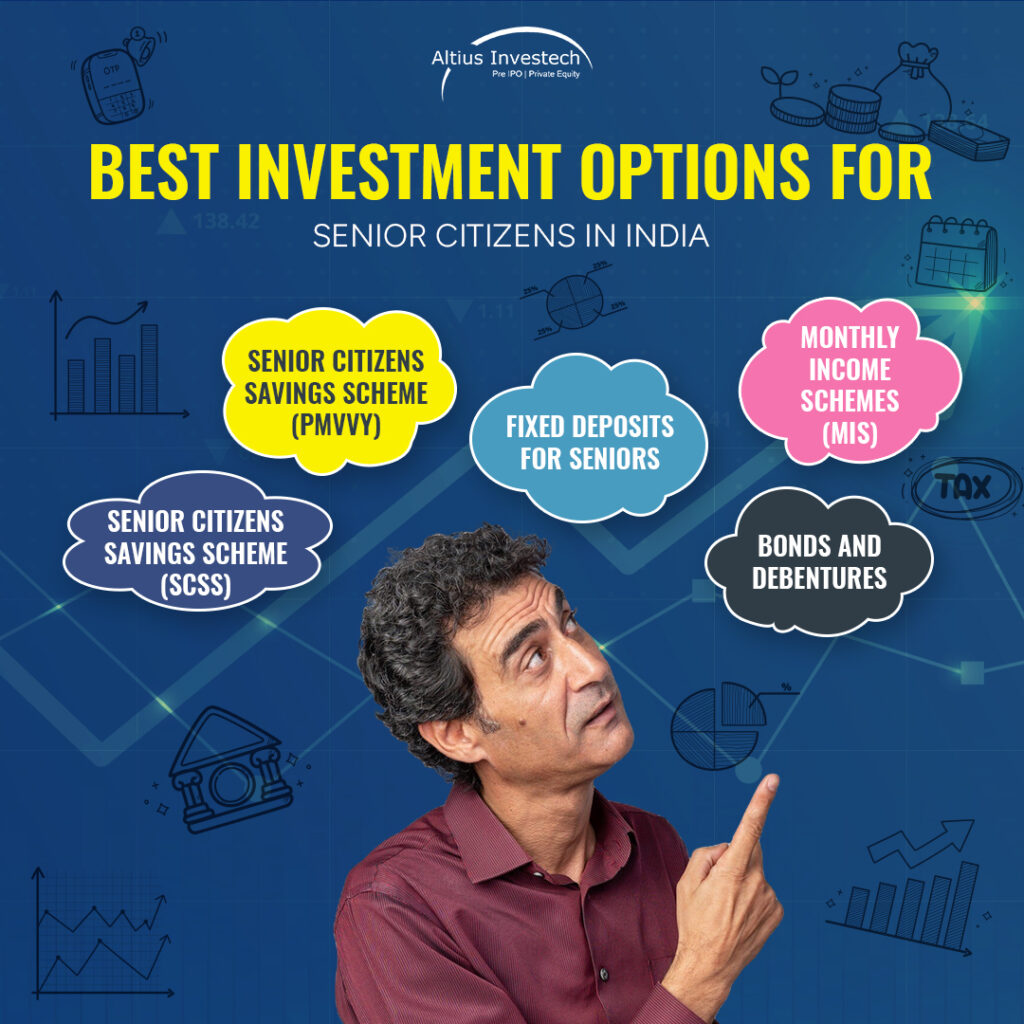Blog Highlights
- Investment Options in India for Short-Term
- Investment Options in India for Long-Term
- Investment Options for Children in India
- Investment Options for Housewives in the Country
- Investment Options for Senior Citizens in India
- Investment Options to Save Tax in India
- Investment Options in India for Salaried Individuals
- Unlisted Shares as an Alternative Investment Option
20 Best Investment Options in India for Higher Returns in 2024
Investments are crucial for growing your wealth and attainment of financial security. With various investment options available, all with unique risk profiles, tax benefits, and returns, selecting the right option could be daunting sometimes. Here we have an in-depth analysis of the best investment options in the country, tailored to various needs and financial goals.
An investment plan gives a roadmap to the financial journey. It helps to decide why, where to invest, and how much to invest to attain financial goals. Making a plan is not a one-time process, one would need to regularly visit or adjust your investment.
Lets explore the best investment options in India for 2024. From stocks to real estate, discover top opportunities to grow your wealth & secure high returns.

Best Investment Options in India for Short Term
1) FDs or Fixed Deposits
Deemed as one of the safest investment options for short-term goals, they provide guaranteed returns, allowing them to be ideal for risk-averse investors. With rates of interest running between 3%-7%, FDs are available in banks and NBFCs, offering flexible tenures from 7 days- 10 years.
The principal on a fixed deposit is never depreciated. The fund maintains security and promises returns free of any market fluctuations.
2) RDs or Recurring Deposits
RDs allow investors to deposit a fixed amount every month, to earn a predetermined rate of interest. They remain suitable for the ones looking for a disciplined savings plan with a short to medium-term horizon.
3) Treasury Bills
The government of India issues treasury bills as a secure way to invest for the short term. Available with maturities of up to one year, they are low-risk investments, ideal for conservative investors.
The Government of India issues Treasury Bills to raise funds for up to 365 days. It is considered an investment with the best returns. But keep in mind that lower risks translate to low returns.
4) High-Yield Savings Account
The accounts offer higher interest rates than regular ‘savings accounts’ providing ease of access to funds and flexibility. High-yield Savings Accounts become suitable for short-term saving objectives and emergency funds.
Best Investment Options in India for Long-Term
1) PPF or Public Provident Fund
PPF is a government-backed long-term savings scheme that has attractive interest rates and tax benefits under Section 80C. Having a 15-year lock-in period, PPF can be ideal for the ones seeking tax-efficient and safe investment options.
One can open a PPF account at any nationalized bank or post office branch. The minimum investment starts at Rs 500, and the maximum goes up to Rs 1.5 lakhs per financial year.
2) Equity Mutual Funds
These funds are those that primarily invest in stocks. One will be able to invest their money in these stocks through SIP, in a large amount, or little by little.
It suits savvy investors who are experts in the market. The risk involved is quite high which could, however, lead to immense profits.
3) ULIPs or Unit Linked Insurance Plan
It is a combination of life insurance and investment. A part of the premium is invested in asset classes such as bonds and equity for the generation of wealth over the long term. Another part of the premium goes into covering the life insurance. Typically, the minimum investment is around Rs 1500 per month.
Best Investment Options for Children in India
1) SSA or Sukanya Samriddhi Account
It is a saving scheme backed by the government to allow you a guaranteed return on your investment. The scheme was launched under the initiative of “Beti Bachao Beti Padhao Abhiyan”, having the objective of promoting girl child education and welfare. A minimum investment of Rs 250 is expected, up to a maximum investment of Rs 1.5 lakh per financial year.
Eligible for deduction of Rs 1.5 lakh under Section 80C. It comes under the EEE category, which means investment made, interest earned, and maturity amount are tax-exempt.
2) Children’s Mutual Funds
It focuses on building a corpus for a child’s future education and other needs. It provides a balanced mix of debt and equity, in order to match long-term growth with moderate risk.
3) PPF or Public Provident Fund
It is a popular choice for building a secure financial future for children due to its safety, tax benefits, and compounding returns over the long term.
4) Gold Investments
Sovereign Gold Bonds are issued by the RBI regularly, as an alternative to physical gold investment.
5) ULIPs or Unit Linked Insurance Plans
ULIPs offer a combination of investment and insurance, making them suitable for parents who want to secure their child’s financial future while enjoying market-linked returns and tax benefits.
Best Investment Options for Housewives in India

1) Post Office Savings Schemes
Backed by the government of India, providing a reliable and safe investment option for housewives. They offer different schemes that have attractive rates of interest and are said to be a good choice for conservative investors.
2) Mutual Funds or SIPs
Systematic investment plans in mutual funds allow housewives to invest small amounts regularly in equity, balanced funds, or debts. SIPs allow the benefits of compounding and rupee cost averaging with time.
A balanced mutual fund, despite being subjected to market risk, is essentially the best investment to grow the money multifold. When you have a low-risk appetite but want high returns, a fixed-income mutual fund or systematic investment plan could be a great option.
3) Gold Investments
Gold investments are a favored choice as noticed in Indian households, allowing for both security, as well as potential appreciation. Options such as SGBs offer added benefits of interest payouts.
4) NSC or National Savings Certificate
NSC is a fixed-income investment scheme suitable for risk-averse investors. It offers guaranteed returns and tax benefits, making it a secure investment option for housewives.
Best Investment Options for Senior Citizens in India

1) SCSS or Senior Citizens Savings Scheme
SCSS has been designed specifically for senior citizens. It offers high interest rates and regular payouts. It is free of risk and the investment is backed by the government and is ideal for retirees.
2) PMVVY or Pradhan Mantri Vaya Vandana Yojana
It offers regular pension payouts for 10 years, making it a great choice for senior citizens who seek stable post-retirement income.
3) Fixed Deposits for Seniors
Senior citizen FDs offer higher interest rates than regular FDs, providing a reliable source of income for retirees wanting stable post-retirement income.
4) MIS or Monthly Income Schemes
Post Office MIS gives regular monthly income, making it a popular choice among retirees preferring regular cash flow investments at low risk.
5) Bonds and Debentures
Bonds, especially government bonds, give fixed returns and are safe. They are a suitable option for seniors wanting to preserve capital as well as earn regular income.
Best Investment Options to Save Tax in India

1) ELSS or Equity-Linked Savings Scheme
ELSS funds invest primarily in equities and offer tax deductions under Section 80C. They are the only mutual funds providing tax benefits, and deemed as suitable for long-term investors.
2) PPF or Public Provident Fund
It is a favorite among people for saving taxes, offering EEE or “Exempt-Exempt-Exempt” status, wherein interest, maturity, and investment amounts are all tax-free.
3) NPS or National Pension System
NPS offers tax benefits under various sections of the Income Tax Act, including an additional deduction of Rs 50,000 under Section 80CCD(1B). It is a compelling choice for retirement savings.
For an NPS Tier 1 account, a minimum investment of Rs 1,000 annually is required to keep the account active, with no upper limit on contributions. In contrast, NPS Tier 2 accounts have no restrictions on the minimum or maximum amount of investments.
4) Health Insurance Premiums
Premiums paid for health insurance policies qualify for deductions under section 80D, helping individuals save tax while securing their health.
5) Home Loan Principal and Interest Payments
Home loan repayments give tax benefits under Sections 80C and 24(b), offering deductions on principal and interest components respectively.
Best Investment Options in India for Salaried Individuals

1) EPF or Employee Provident Fund
It is a mandatory savings scheme for salaried employees, providing guaranteed returns as well as tax benefits. It serves as a critical component of retirement planning in the case of working-class individuals.
2) SIPs or Systematic Investment Plans
It includes regular investments by salaried individuals as a way to build wealth systematically. These investments occur in diverse asset classes as per their risk profile and financial goals.
3) VPF or Voluntary Provident Fund
VPF lets employees contribute more than the mandatory 12% of their basic salary to the EPF account, yielding high retirement savings with tax benefits.
4) Direct Equity Investments
This can induce significant growth of wealth for salaried people. This option demands a proper understanding of the market dynamics as well as a higher risk appetite.
It serves as a great investment for the long term as well. It is an equity share of a company bound by legal terms related to company ownership. When one buys an equity share, one earns the right to be involved in the company’s decision-making. However, equities hold a high hand when it comes to risk.
For example, the Indian non-banking financial company Bajaj Finance has delivered an annualized return of over 44.1% in the last 15 years.
5) Corporate Bonds
It is a mutual fund that invests more than 80% of the total financial resources in corporate bonds. Business organizations sell these to fund short-term expenses, like working capital needs, insurance premium payments, and advertising.
Unlisted Shares as an Alternative Investment Option
Unlisted shares, such as those offered through platforms like Altius Investech, are equity investments in companies that are not publicly traded on stock exchanges. This provides investors with early entry into potentially high-growth companies, often before they become available on public markets. By investing in these companies early, investors have the opportunity to benefit from significant returns as the company scales or prepares for an IPO, making unlisted shares a valuable addition to any diversified investment portfolio.
How to Invest in Unlisted Shares
Investors would be able to acquire shares through brokers, private equity, and employee stock options. They are less liquid but remain rewarding for patient investors.
Popular Unlisted Shares in India
Prominent examples include shares of companies like Paytm, Ola, & Reliance Retail, that offer opportunities before they can be publicly listed.
If you’re interested in investing in unlisted shares, be sure to read our blogs dedicated to this topic for valuable insights and guidance.
- 5 Advantages of Buying Unlisted Shares in 2024
- Demystifying Unlisted Shares: How They Work
- Mitigating the Risks of Buying Unlisted Shares
- Income Tax on Capital Gains in Unlisted Shares
- Listed Vs. Unlisted Shares: Assessing Risk and Reward
- Top 5 Unlisted Shares You Should Consider Buying in India in 2024
Final Thoughts
A diversified portfolio is key to maximizing returns and minimizing risk. Aligning investments with individual financial goals, risk tolerance, and investment horizon can help secure your financial future. Consult a financial advisor to tailor your investment strategy to your unique needs.
GET IN TOUCH WITH US
For any query/ personal assistance feel free to reach out at support@Altiusinvestech.com or call us at +91-8240614850.
For Direct Trading, Visit – https://altiusinvestech.com/companymain

